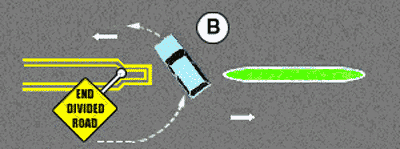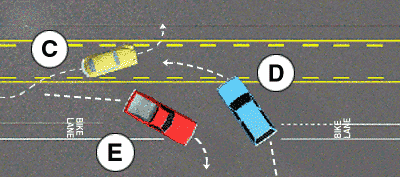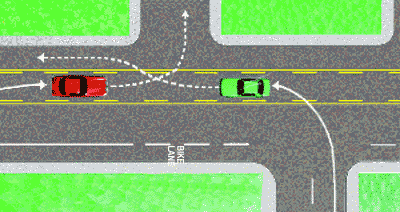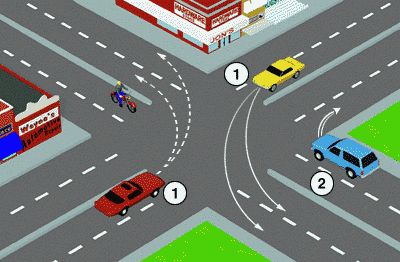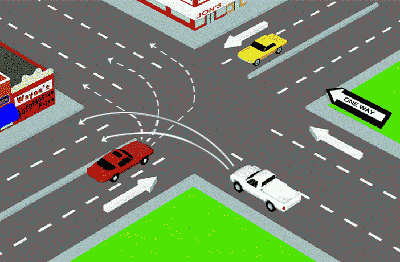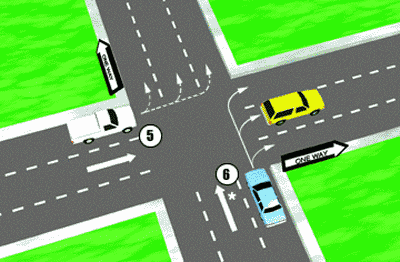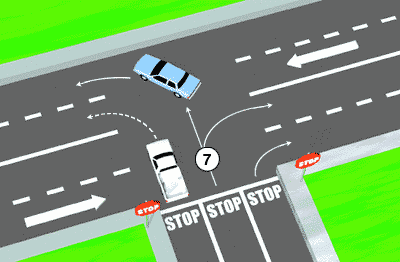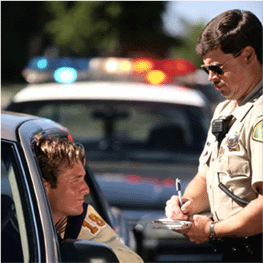Cal-Driver-Ed.Com |
|
California's Home Study Driver Education Class |
To easily find this site again, hit Ctrl+D, or drag this link: Cal-Driver-Ed to your Favorites.
| Log-In | Driver Education | Driver Training | DMV Requirements | FAQs | Compare | Contact Us |
|
The California DMV Driver Handbook |
A* You may cross a solid double yellow line to turn left.
Yes, OK to cross double yellow to turn left. No, do not cross double yellow to pass another vehicle. B* Two sets of solid double yellow lines which are spaced two or more feet apart sometimes appear as a road marking. Such lines stand for a solid wall. Don’t drive on or over such a road marking. You may not make a left turn or a U-turn across it. Cross only at plainly marked openings.
C and D* A center left turn lane is in the middle of a two-way street. The lane is marked on both sides by two painted lines—inner line broken, outer line solid. You must use this lane to begin left turns or to start a permitted U-turn.
E* Move into the broken-line bike lane no more than 200 feet before turning right. Watch for bicycles and foot traffic. If a street has a center left turn lane, you must use it when you turn left (VC §21460.5[c]). You may only drive for 200 feet in the center left turn lane. This lane is not a regular traffic lane or a passing lane. To turn left, signal and drive completely inside the center left turn lane. Don’t stop part way into the lane, with the back of your vehicle blocking traffic. Make sure the lane is clear in both directions and then turn only when it is safe. Look for vehicles coming toward you in the same lane as they start to make their left turns.
When turning left from a side street or driveway, signal and wait until it is safe. Then drive into the center left turn lane. Enter traffic only when it is safe. You may drive across a center left turn lane. Right Turn Against A Red Light. Signal and stop for a red traffic light at the limit line, if there is one, or before entering the intersection. If there is no sign which prohibits a right turn on the red light, you may turn right. Be careful that you do not interfere with pedestrians, bicyclists, or vehicles moving on their green light. Left Turn Against Red Light On A One-Way Street Only. Signal and stop for a red traffic light at the limit line, if there is one, or before entering the intersection. On a one-way street, you may turn left into a one-way street where traffic moves left if there is no sign which prohibits the left turn. If the light is red, be very careful that you do not interfere with pedestrians, bicyclists, or vehicles moving on their green light. No Turn Against A Red Arrow. A right or left turn may not be made against a red arrow. Examples Of Right And Left Turns The numbers on the cars refer to the numbered sentences on these pages. Signal in each situation.
1. Left turn from a two-way street. Start the turn in the left lane closest to the middle of the street. You may complete the turn in either lane of the cross street (as shown by arrows) if it is safe to do so. You must use a left turn lane if there is one. A left turn from the next lane may be made if signs or arrows show it is okay. 2. Right turn. The vehicle is turning correctly. Do not swing wide into another lane of traffic. Begin the turn in the lane nearest the right-hand curb and end in the lane nearest the right-hand curb. You may start a right turn from other than the far right lane only where pavement or overhead mark-ings show that using that lane for a right turn is permitted.
3. Left turn from a two-way street into a one-way street. Start the turn from the far left lane on your side of the road. You may turn into any lane that is safely open, as shown by the arrows. 4. Left turn from a one-way street into a two-way street. Start the turn from the far left lane. The vehicle may turn into either of the lanes that is safely open, as shown.
5. Left turn from a one-way street into a one-way street. The turn must be started from the left hand portion of the road. Watch for bicycles between your vehicle and the curb because they can legally use the left turn lane for their left turns. 6. Right turn from a one-way street into a one-way street. Start the turn in the far right lane. You may use any lane, if safe to do so. Sometimes signs or pavement markings will let you turn right from a lane next to the far right lane (shown by *).
7. Turn at a “T” intersection from a one-way into a two-way street. Through traffic has the right-of-way. You may turn either right or left from the center lane. Watch for vehicles and bicycles inside your turn. When you make a U-turn, you turn around and go back the way you came. Signal and then make the U-turn only from the far left lane on your side of the road. If the street has a center left turn lane, begin your U-turn in that lane. You may make a U-turn:
Never make a U-turn on a highway by crossing a curb, or strip of land, or two sets of double lines. You may not make a U-turn: • Where you cannot clearly see 200 feet in each direction because of a curve, hill, rain, fog, or other reason. • Where a ?NO U-TURN? sign is posted. • When vehicles may hit you. • On a one-way street. • In front of a fire station. Never use a fire station driveway to turn around. • In a business district*, except at intersections or through openings in a concrete divider. Freeway lanes (as well as some city street lanes) which are ending will usually be marked by large broken lines painted on the pavement. If you are driving in a lane marked with these broken lines, be prepared for the lane to end or to exit the freeway. Look for a sign to tell you what to do (i.e., merge right, right lane must exit, etc.). |
26 27 28 29 30 31 32 33 34 35 36 37 38 39 40 41 42 43 44 45 46 47 48 49 50 Glossary
|
Our Driver Education Course is Accepted by the California DMV View Our California DMV Verification Letter Sample DMV Driver Education Certificate of Completion  "Cal-Driver-Ed is a pioneer in the field of online driver education. Over 80,000 California teenagers have taken their courses and are driving today." "I recommend Cal-Driver-Ed for home study driver education." The following quotes are excerpts from a California DMV Study on the Effectiveness of Home-Study Driver Education (PDF) dated April 2003: "Home-study students performed just as well or better than classroom students ... " "Home-study courses may also have the additional benefit of increasing parental involvement in their teen's learning process, which has been shown to be an important factor ..." |
|
Cal Driver Ed is proud
|
|
Already Have Your License? Traffic school will help keep your auto insurance costs lower if you receive a traffic ticket. Every licensed California Driver must have auto insurance to drive a vehicle in California. Proof of insurance must be provided to the California DMV when you obtain your drivers license (not your learners permit). Proof of auto insurance must also be provided to DMV when you register or renew the license on a vehicle you own. |

